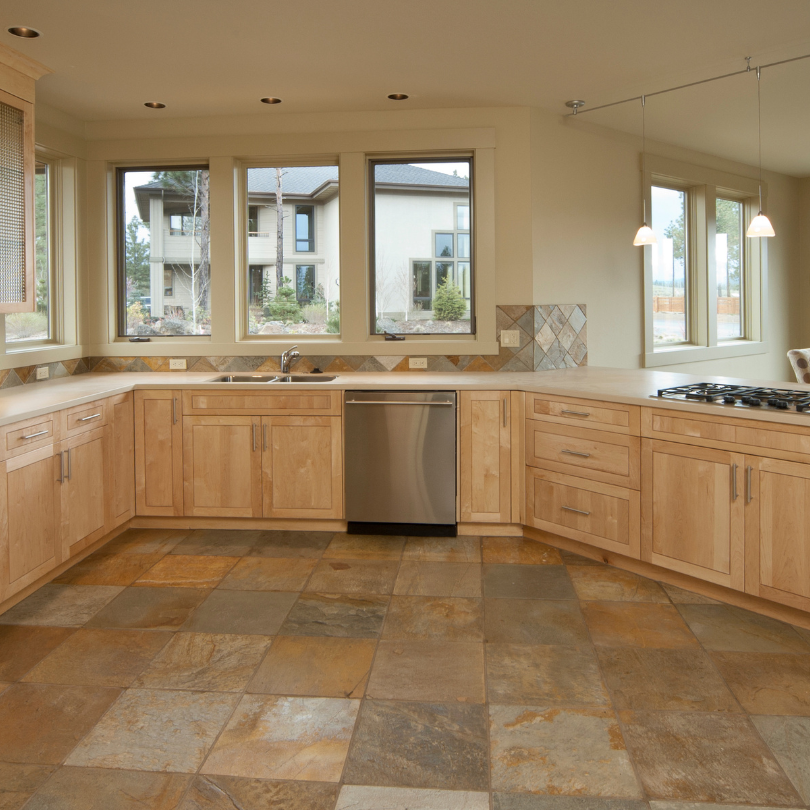In the modern home, the kitchen is an essential social area used for preparing meals, cooking, dining and even socializing with loved ones in an intimate, lively setting. Therefore, good design is important when planning or remodeling a kitchen.
Tiles are a relatively easy way of adding visual flair and elegance to a space using beautiful patterns, luxurious colors, and an appealing finish. Tiles come in different sizes, colors, and textures and can be used for floors and walls.
Different kinds of tiles have varying attributes that make them suited for use on a kitchen floor.
Here is everything you need to know when looking for the best floor tiles for your kitchen.
Which kitchen floor tiles are best?
Natural Stone Kitchen Floor Tiles

This includes materials like limestone, marble, travertine, or slate.
Advantages
Natural stone is durable and visually stunning. It can also create a unique finish in the kitchen because no two slabs of stone have the same look.
There are many natural stone varieties to choose from, and they range from neutral shades to dark tones which can be chosen to complement the overall color palette.
Drawbacks
Natural stones of significant quality will typically cost more than other tile choices, and this may affect what you can afford for other elements of your kitchen.
Stone also requires more intensive care compared to alternative tile materials. Stone is porous in varying degrees and thus may need extra attention such as applying sealant once every year.
Porcelain Kitchen Floor Tiles

Porcelain requires less maintenance than natural stone while offering a similar appearance.
Advantages
Porcelain is highly durable and therefore ideal for a high-traffic area like a modern kitchen. It is also quite dense and water-resistant, and this makes it easy to clean.
Porcelain is also quite versatile and can replicate the look of other materials such as wood and stone. It also costs less than natural stone which grants some reprieve to your budget.
Drawbacks
Porcelain is susceptible to chipping after a while, and its white interior can be exposed after the top surface is compromised.
Ceramic Kitchen Floor Tiles

This is a popular floor tile option that offers nearly endless style choices.
Advantages
Ceramic tiles are pocket friendly and easy to look after. The material is quite resistant to stains and moisture.
Ceramic tiles can help you create a colorful, subtle, patterned, matte or gloss finish. Ceramic tiles do not need sealing and are easier to clean compared to natural stone floor tiles.
Drawbacks
Compared to porcelain, ceramic tiles are more porous.which means that it is prone to staining after a while. It may also result in mold growing underneath the tiles thus compromising their structure.
Ceramic tiles are not also the most durable tile option compared to porcelain and natural stone. Its interior can be exposed if the top surface becomes chipped.
Kitchen floor tile considerations
Water resistance
While a kitchen floor does not get as wet as the bathroom, it still has its fair share of spills. You need a tile with a reasonable level of water resistance and therefore, you ought to look out for how porous the tile is.
Texture
Tiles with a glazed shiny finish can be stunning but there are other safer options. These qualities make them slippery which is a serious hazard especially if you have children, pets, and seniors.
Therefore, consider a flooring tile option with more texture and foot feel to keep everyone safe on their feet with little chance of slipping.
Budget
Remember that you have to pay a premium for natural tile materials like marble. However, if you have a strict budget, ceramic tiles are a good option that can stand the test of time with a bit of care.
If you can afford porcelain, it is a great choice because it is durable and easy to clean.
Size of the kitchen
Light colors will reflect light to make your kitchen appear larger. Also, small tiles will accentuate the appearance of small spaces, while large tiles will make the room appear larger.
Staining
Remember that different tiles stain in different ways and require some effort to be removed. Experts recommend mixing half a cup of vinegar with a gallon of water to clean kitchen floor tiles.
You should rinse the floor with warm water after cleaning stains to remove all of the liquid from the tiles.
Cleaning and maintenance
To clean up kitchen floor tiles, spray the area with a neutral cleaning substance and wipe off excess with a clean cloth. Try to avoid leaving spots of moisture as these can be slippery and hard to see.
For liquid spills, blot them up with a clean dry cloth and then use tile cleaner as normal.
For mud, let it stain dry completely before mopping up with a mixture of cleaning liquid and water using a clean cloth or a mop.
Use a vacuum or a broom to get rid of loose dry dirt before washing kitchen flloor tiles.
Which kitchen floor tiles do not show dirt?

If you are interested in a kitchen floor tile that does not show dirt, experts advise staying away from extremely light color tones.
Matte finishes also do not show as much dirt as glossy tiles, and this may also affect the risk of slipping.
If you are a keen cook, or you have children around, you may want a floor tile and this easy to clean such as porcelain. It is non-porous and will be a stain-proof option that is ideal for a high-traffic area.
What is the most durable tile for kitchen floors?
Porcelain and natural stone are the most durable options for kitchen floor tiles. High-quality stone and porcelain are extremely hardwearing and will look good in your kitchen for many years to come.
What is trending in kitchen floors?

Light-colored tones are trending in the world of kitchen flooring materials, in addition to natural materials. These contribute to the extremely popular look that seamlessly integrates with other elements in a kitchen.
Homeowners are also leaning towards large tile sizes, which helps to minimize the number of grout joints used.
For a wood flooring texture, experts advise considering vinyl kitchen flooring ideas such as luxury ceramic tiles. These can be tailored to mimic the appearance of wood or natural stone with the added benefit of being easy to clean and water resistant.
Hexagonal, diamond shapes and chevrons are shaking up the status quo of kitchen floor tile ideas. Many homeowners are laying oblong tiles in a herringbone shape, in addition to incorporating terrazzo.
Conclusion
Tiles are a good choice for kitchen flooring because they are durable, not susceptible to prolonged exposure to moisture, and can provide a neutral basis from which to create a lively pattern.
You can pick from natural stone, ceramic, and porcelain tiles, with each variety having its own characteristics that make them suitable for various preferences.
Many people prefer porcelain tiles because they are durable and can be cleaned easily.
Like other kitchen finishing options, the right kind of flooring depends on your maintenance needs and desired aesthetic.







Leave a comment
This site is protected by hCaptcha and the hCaptcha Privacy Policy and Terms of Service apply.